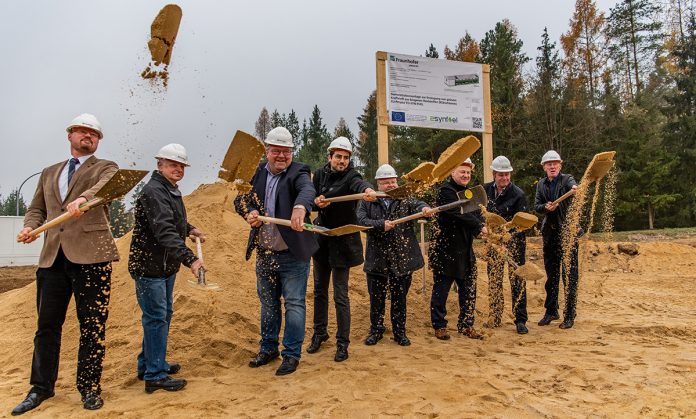The HORIZON 2020 ToSynFuel project, coordinated by Fraunhofer UMSICHT, will demonstrate new integrated waste valorisation technologies into industrially relevant environments, says Dr-Ing Robert Daschner from Institute Branch Sulzbach-Rosenberg
At the end of 2015, the European Commission adopted an ambitious Circular Economy Package to stimulate Europe’s transition towards a circular economy, which will boost global competitiveness, foster sustainable economic growth and generate new jobs.
The actions to be implemented will contribute to “closing the loop” of product lifecycles through greater recycling and re-use of resources, and bring benefits for both the environment and the economy. The plans will extract the maximum value and use from all raw materials, products and waste, fostering energy savings and reducing greenhouse gas emissions and environmental impact. The full lifecycle is covered: from production and consumption to waste management and the market for secondary raw materials. This transition will be supported financially by European Structural and Investment Funds, €650 million from Horizon 2020 (the EU funding programme for research and innovation), €5.5 billion from structural funds for waste management, and investments in the circular economy at a national level.
The circular economy has the potential to preserve precious and scarce resources, reducing environmental impacts of resource use and injecting new value into waste products. Key actions to be carried out under the current Commission’s mandate include also a revised regulation on fertilisers, to facilitate the recognition of organic and waste-based fertilisers in the single market and support the role of bio-nutrients.
The legislative proposals on waste, adopted together with this action plan, include long-term targets to reduce landfilling and increase preparation for reuse and recycling of key waste streams.
Use of sewage sludge as a resource rather than waste to dispose
Recycled nutrients from organic waste or by-products (bio-based materials such as food waste, used water and animal by-products such as manure) can be returned to the soil as fertilisers, reducing the need for mineral-based fertilisers and creating organic fertilisers for EU farmers and gardeners.
The circulation of these fertilisers is hampered by differing rules and quality standards across EU countries.
Today the majority of fertilisers used are manufactured from imported resources or through energy-intensive processes. The revised Fertilisers Regulation adopted by the Commission in 2016 foresees changes to allow the recycling of nutrients through the production of waste-based and organic fertiliser products.
For example, in order to meet the future global needs of phosphorus, it is likely that phosphate recovery and recycling from sludge liquid effluents will become more economically competitive, leading to increased uptake. In various EU countries new sewage sludge directives are already in place, forcing phosphate recovery.
The organic fraction of municipal solid waste (OFMSW) and sewage sludge represent a large amount of the biodegradable waste generated in the EU. The most recent estimates, reported to the Commission by the Member States, suggest that about 100 million tonnes of biowaste from municipal solid waste and sewage sludge dry matter are produced in the EU every year. Sewage sludge evolves from the treatment of waste water to produce a ‘sludge cake’. It is a highly abundant waste with a yearly production potential of approximately 90 kg per inhabitant per year (wet basis). Germany currently produces 1.8 million tonnes per year of sewage sludge on a dry basis. Similar to anaerobic digestion residues, there are increasing legislative demands imposed on the disposal of sewage sludge by landfill, land spreading and incineration.
In Italy and according to Eurostat data, landfill remains the major disposal route for sewage sludge, followed by land spreading. In countries such as Germany or Netherlands, incineration is applied to a higher degree. Considering Europe consists of 28 countries, the most commonly used disposal method in 2012 was land spreading, followed by incineration and then composting and landfill.
Ultimately, the choice of the most appropriate management and treatment process for sewage sludge is, of course, deeply related to the local conditions. It is known that landfill disposal of sludge affects the leachate production and the CO2 emissions directly to the air. Therefore, the main methods of sewage sludge management in the EU remains agricultural use and incineration.
ToSynFuel project to convert sewage sludge in value-added products
ToSynFuel is a Horizon 2020-funded project coordinated by the Fraunhofer Institute for Environmental, Safety, and Energy Technology (Fraunhofer UMSICHT) in Germany. It has developed a waste conversion technology called Thermo-Catalytic Reforming (TCR®), which has the potential to have a significant impact on addressing sustainable energy, economic, social and environmental needs.
The project consortium comprises of key industrial stakeholders with the knowledge and expertise to develop and operate a pre-commercial demonstrator, which is the basis for a first-of-its-kind industrial unit.
The technology converts residual biomass into three main products: biochar (containing phosphorus and potassium), hydrogen-rich synthesis gas, and liquid bio-oil that can be refined into high-grade bio-fuels.
For this particular project, the researchers are focusing on sewage sludge, but the waste conversion technologies are extremely versatile. Within the ToSynFuel project, sewage sludge will be tested as the feedstock, but the technology combination of TCR® with pressure swing adsorption (PSA) and hydro-deoxygenation (HDO) can convert a broad range of residual biomass like digestate from anaerobic digestion plant, biowaste and oil pomace.
The technology integration will be shown within ToSynFuel through a demonstrator located beside a sewage sludge drying plant. Such plant locally dries and produces sewage sludge feedstock, currently about 10,000 tons per year. Sludge driers at this scale are common in German infrastructure, complying with the new EU legislation concerning the sludge processing. Sewage sludge has shown great potential for being utilised as a feedstock for TCR® conversion due to its availability, low cost and high energy content, and the fuel properties obtained from the bio-oil. Processing 2 million tonnes per year of sewage sludge into TCR® products would be sufficient to produce up to 200,000 tonnes per year of liquid transport fuels as well as up to 1,000,000 tonnes of biochar with about 70,000 tonnes of phosphorous. This will represent a significant contribution to the circular economy.
Biochar from sewage sludge can be gasified in a simple gasification system, the so called updraft gasifier to increase the energy yield. The obtained ash is in powder form and the contained phosphorous can create nutrient rich soil that can be readily adsorbed by plants.
References:
http://europa.eu/rapid/press-release_IP-15-6203_en.htm
COM(2015) 614 final Closing the loop – An EU action plan for the Circular Economy
Profile in OAG January 2019 issue
This project has received funding from the European Union’s Horizon 2020 research and innovation programme under grant agreement No 745749.
Please note: This is a commercial profile
Dr-Ing Robert Daschner
Head of Department Renewable Energy
Institute Branch Sulzbach-Rosenberg of Fraunhofer-Instituts für Umwelt-,
Sicherheits- und Energietechnik UMSICHT
Tel: +49 (0)9661 908 410











